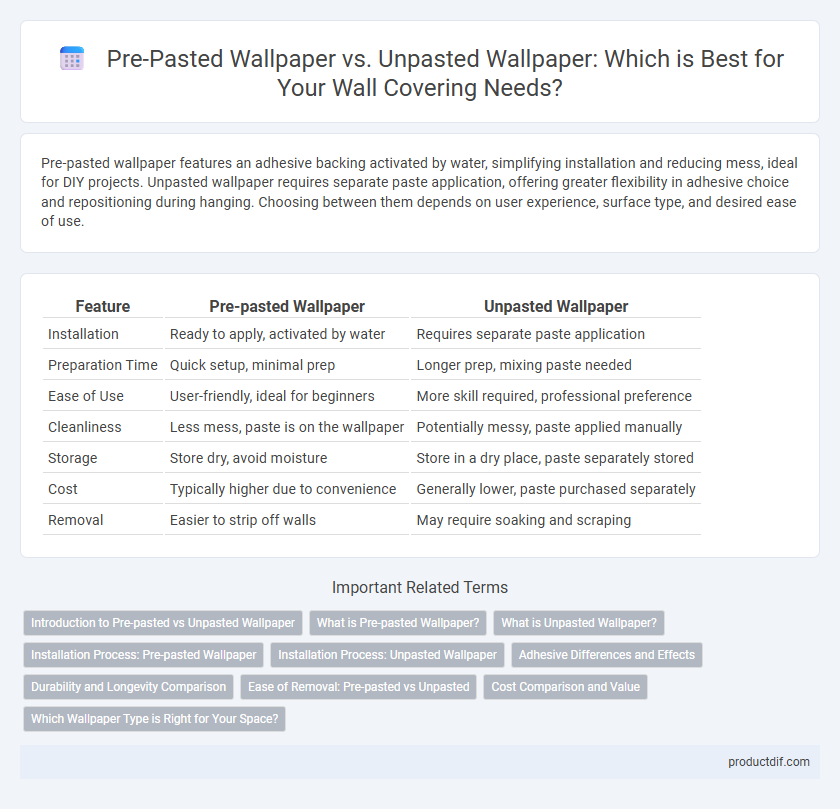Pre-pasted wallpaper features an adhesive backing activated by water, simplifying installation and reducing mess, ideal for DIY projects. Unpasted wallpaper requires separate paste application, offering greater flexibility in adhesive choice and repositioning during hanging. Choosing between them depends on user experience, surface type, and desired ease of use.
Table of Comparison
| Feature | Pre-pasted Wallpaper | Unpasted Wallpaper |
|---|---|---|
| Installation | Ready to apply, activated by water | Requires separate paste application |
| Preparation Time | Quick setup, minimal prep | Longer prep, mixing paste needed |
| Ease of Use | User-friendly, ideal for beginners | More skill required, professional preference |
| Cleanliness | Less mess, paste is on the wallpaper | Potentially messy, paste applied manually |
| Storage | Store dry, avoid moisture | Store in a dry place, paste separately stored |
| Cost | Typically higher due to convenience | Generally lower, paste purchased separately |
| Removal | Easier to strip off walls | May require soaking and scraping |
Introduction to Pre-pasted vs Unpasted Wallpaper
Pre-pasted wallpaper comes pre-coated with adhesive on the back, requiring only activation with water before application, which simplifies installation and reduces mess. Unpasted wallpaper, also called paste-the-wall or dry wallpaper, necessitates manually applying adhesive to either the wallpaper or wall, offering customizable adhesion strength and suitability for various wall types. Choosing between pre-pasted and unpasted wallpaper depends on factors such as installation experience, wall surface condition, and project size.
What is Pre-pasted Wallpaper?
Pre-pasted wallpaper features a ready-to-use adhesive backing activated by water, eliminating the need for separate paste application. This type of wallpaper simplifies installation, reduces mess, and speeds up the hanging process, making it ideal for DIY projects. Popular brands like York and Brewster offer pre-pasted options that provide durability and ease of maintenance.
What is Unpasted Wallpaper?
Unpasted wallpaper is a type of wall covering that requires the user to apply adhesive separately before installation, offering greater control over paste application and reducing the risk of bubbles or wrinkles. Unlike pre-pasted wallpaper, unpasted versions often provide a wider variety of textures and designs, making them ideal for custom interior projects. This wallpaper type is favored by professional decorators for its flexibility in handling and precision in achieving seamless wall finishes.
Installation Process: Pre-pasted Wallpaper
Pre-pasted wallpaper features an adhesive layer activated by water, streamlining the installation process by eliminating the need for separate paste application. Users simply soak the wallpaper strips, then align and smooth them directly onto the wall, reducing setup time and mess. This type of wallpaper is ideal for DIY projects, offering a more convenient and user-friendly installation experience compared to unpasted wallpaper.
Installation Process: Unpasted Wallpaper
Unpasted wallpaper requires applying adhesive directly to the back of the paper before installation, demanding more preparation time and precision. The process involves spreading paste evenly with a brush or roller to avoid lumps and ensure proper adhesion to the wall. This method offers greater flexibility in controlling the wallpaper application but can be messier compared to pre-pasted options.
Adhesive Differences and Effects
Pre-pasted wallpaper features a pre-applied, water-activated adhesive that simplifies installation by eliminating the need for separate glue preparation, reducing mess and curing time. Unpasted wallpaper requires manual application of adhesive, allowing customization of glue type for different wall surfaces but increasing preparation time and risk of uneven adhesion. The choice between pre-pasted and unpasted options impacts durability, ease of hanging, and potential for future removal or damage to wall surfaces.
Durability and Longevity Comparison
Pre-pasted wallpaper features a ready-to-use adhesive layer activated by water, enhancing ease of application and providing a strong bond that resists peeling over time, contributing to increased durability. Unpasted wallpaper requires separate adhesive application, which can lead to inconsistent coverage and reduced adhesion, potentially decreasing its longevity when exposed to moisture or frequent cleaning. Studies indicate pre-pasted wallpapers generally maintain structural integrity longer, especially in high-traffic or humid environments, making them a preferable choice for lasting wall coverage.
Ease of Removal: Pre-pasted vs Unpasted
Pre-pasted wallpaper features an adhesive layer activated by water, allowing for simpler removal as it often peels off in larger sheets without the need for strenuous scraping. Unpasted wallpaper requires manual application of glue, making the removal process more labor-intensive, often involving soaking and scraping to prevent wall damage. Choosing pre-pasted wallpaper can significantly reduce time and effort when updating or redecorating interior walls.
Cost Comparison and Value
Pre-pasted wallpaper generally offers lower initial costs due to easier installation, reducing the need for professional help and additional adhesives. Unpasted wallpaper tends to have higher upfront expenses but provides better long-term durability and customization options, often resulting in greater overall value for frequent renovators. Evaluating both types based on installation convenience and lifespan helps determine the most cost-effective wall covering solution for your specific project.
Which Wallpaper Type is Right for Your Space?
Pre-pasted wallpaper offers convenience with adhesive already applied, making it ideal for quick, mess-free installation in high-traffic areas or rental properties where ease of removal matters. Unpasted wallpaper requires separate paste application, providing more control over adhesion strength, perfect for textured walls or complex surfaces requiring durable, long-lasting coverage. Choosing between pre-pasted and unpasted wallpaper depends on your skill level, wall condition, and how permanent you want the wall covering to be.
Pre-pasted Wallpaper vs Unpasted Wallpaper Infographic

 productdif.com
productdif.com